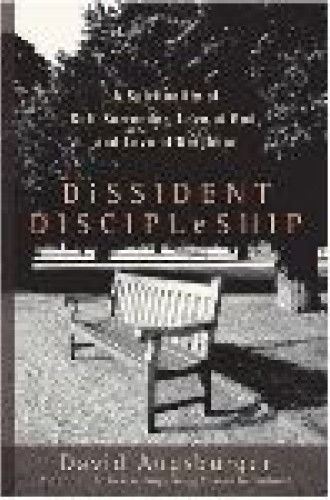'Follow me'
The word disciple appears 269 times in the New Testament, and the word Christian shows up a scant three times. So notes Dallas Willard, who declares that the church today has inverted that emphasis: being a Christian in many churches does not necessarily entail being a disciple—a student, follower or apprentice of Jesus. But that may be changing. These books and a host of others in recent years focus on discipleship.
Discipleship appears to be a crossover concept, compelling to both mainliners and evangelicals. For evangelicals the turn to discipleship represents a growing awareness that they have too often promoted a gospel reductionism, focusing primarily on conversion and eternal salvation and neglected a way of life here and now. Willard calls this “vampire Christianity.” A vampire Christian says to Jesus, in effect: “I’d like a little of your blood, but I don’t care to be your student. . . . In fact, won’t you just excuse me while I get on with my life, and I’ll see you in heaven.”
For mainliners, the theme of discipleship helps congregations that are wrestling with the end of Christendom and enables them to move beyond a vague civic faith that tends to become a religion of good works and achievement and that boils Christianity down to being a good person. Discipleship builds on the longstanding mainline emphasis on Jesus as teacher and example, but instead of universalizing Jesus’ claims and in the process watering them down, it involves a robust set of faith practices.
For both evangelical and mainline writers, the theme of discipleship builds on the now generation-long emphasis on faith as a set of practices, inspired by Alasdair MacIntyre and his seminal book After Virtue. MacIntyre persuasively argued that practices are the behaviors that embody and sustain a way of life in a community shaped by a particular moral telos or purpose. This emphasis on practices has helped people think about Christianity not so much as a set of beliefs but as a way of life—a theme stressed in different ways by both Jonathan Wilson and David Augsburger.
A focus on discipleship can move congregations beyond the church-as-club contagion. Symptoms of the contagion include the idea that the main point of the church is to provide for the comfort and satisfaction of its members, that clergy are chaplains who provide religious services, that length of congregational membership is more important than faith or faithfulness, and that the history and lore of the particular congregation override and supersede the importance of scripture or sacraments.
Another way to name the tendency of churches to morph into clubs is to speak of a “membership culture,” a term employed by Michael Foss, a Lutheran pastor and author of several works on discipleship, including Power Surge. In churches with a membership culture, people come to think that church offers staff, services and programs for its members. Guests are welcome, but can stick around only if they pay their dues. A reliable indicator that a church is becoming a club is the default form that introductions take: when club has supplanted church, introductions will often begin with a person stating how long he has been a member (“I’m Bob, and I’ve been a member here since 1982”) rather than reflecting on his own life as a disciple of Jesus Christ.
In the church as club, the question “Why are we here?” tends to be answered with “to meet the needs of our members” or “to be a caring community.” When the focus is on discipleship, a more likely answer is “to be and make disciples of Jesus Christ—to join God in making disciples.”
Jeffrey Jones’s excellent book begins with a pastoral breakdown: the moment when the pastor says to himself or herself, “This isn’t working”—“this” being “the institutional church” or “the program church” or “the traditional church.” Support for the budget is down, people seem unwilling to serve on boards and committees, all sorts of other interests and commitments are eclipsing church attendance and participation, and pastors are incredibly busy but with little to show for it.
“It was sometime in 1993,” writes Jones, “that I verbalized a thought that had been gradually forming in my mind for a number of years. . . . When I said it board members were taken aback. I was shocked. . . . The statement I made that fateful night was: virtually all the old answers about what it means to be and do church don’t work anymore.” For some at least, a breakdown leads to a breakthrough. It leads to ways of doing church in a new time. Often the breakthrough involves turning to the theme of discipleship.
The shift away from the program-driven model of church is a central theme of Thom Rainer and Eric Geiger’s intriguing Simple Church. The authors are evangelicals who have studied a number of churches and concluded that vitality is to be found via simplicity, not complexity. Complex churches disguise a lack of vitality with busyness. Such churches have a lot going on—in fact, too much. Sometimes these churches are described, tellingly, as “full-service churches.” Different staff members are responsible for different programs. Often as not, however, programs and staff compete with one another for resources and loyalty. The church becomes cluttered, complex and congested.
It turns out, according to Rainer and Geiger, that the full-service program church isn’t working. It’s too complicated, too confusing. The purpose is not clear.
Rainer and Geiger urge a shift from programs to process. “A simple church,” they write, “is a congregation designed around a straightforward and strategic process that moves people through the stages of spiritual growth.” It may be a process that moves people, as in one congregation they studied, from the “foyer” to “the living room” and on to “the kitchen” of congregational life. Or it may be a process, as another congregation frames it, of “connecting, growing, and serving.” Whatever the words, the process is clear, and everything a congregation does serves this process. One of their chapter titles is revealing: “Focus: Saying No to Almost Everything.” Just because an idea or proposal is a good one doesn’t mean the church has to act on it.
In shifting emphasis from program to process, Rainer and Geiger follow the insights of Rick Warren’s Purpose Driven Church, which urged: “Don’t focus on growing a church with programs, focus on growing people with a process.” Warren’s own process features the image of a baseball diamond: the aim is to move people from first base (membership) to second base (mature faith) to third base (ministry) and then to home plate (life purpose and mission). I suspect that Rainer and Geiger’s “less is more” formulation will appeal to many pastors and church leaders who feel that they’ve “tried everything, but nothing seems to work.”
But the emphasis on “what works” suggests a danger. Pragmatic Americans tend to look for what works, and discipleship or focusing on a simple and strategic process for spiritual growth could become another fad, another quick fix. This is where the books by Willard, Wilson and Augsburger are helpful. They provide theological and biblical depth for a shift from program to process, from a membership culture to a discipleship culture.
Wilson, much influenced by MacIntyre, attempts to address what has been a deficit in the evangelical world—its underdeveloped ecclesiology, or doctrine of the church. One especially intriguing feature of Wilson’s book is an appendix in which he examines the ecclesiologies (or lack of same) of four well-known evangelicals: Francis Schaeffer, Chuck Colson, Rick Warren and Brian McLaren. Wilson gives extended attention to worship, as well as to the practices of baptism, Eucharist and foot washing. He speaks of discipleship as “human flourishing.”
That notion of discipleship as “flourishing” is also present in Willard’s The Great Omission. The term may seem strange for those who, influenced by Dietrich Bonhoeffer’s The Cost of Discipleship, want to stress the demands of discipleship (Bonhoeffer’s own martyrdom was a powerful illustration of costly discipleship). But such an approach can make it seem as if discipleship is reserved for “super-Christians.” Willard writes about “the joy of discipleship” and “the cost of nondiscipleship.”
Nondiscipleship, Willard says, “cuts you off from abiding peace, a life penetrated throughout by love, a faith that sees everything in the light of God’s overriding governance for good, a hopefulness that stands firm in the most discouraging of circumstances, a power to do what is right and withstand the forces of evil. In short, nondiscipleship costs you exactly the abundance of life that Jesus said he came to bring.”
Augsburger, who writes from an Anabaptist perspective and is given to aphorisms and an abundant use of illustrative and parable-like stories, draws a contrast between popular spirituality and discipleship. “Spirituality is finding inner peace. Discipleship is making peace.” Augsburger challenges evangelicals who emphasize what Jesus has done and conclude that there’s nothing much left to do but sing his praises, and he also challenges liberals who do not read the texts of scripture deeply, who tend to universalize Christian claims and who don’t care much for obedience.
The new focus on the old theme of discipleship promises to be fruitful for congregations and a possible bridge between evangelicals and mainline liberals. For a long time we have listened to the Great Commission at the end of Matthew and misunderstood Jesus to have said, “Go therefore and make members” instead of “make disciples.” Making disciples strikes me as not only more faithful but a good deal more interesting.









